

 Share This Page
Share This Page| Home | | Sailing | | Alaska 2009 | |  |  |  Share This Page Share This Page |
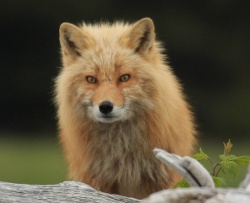
Copyright © 2009, P. Lutus. All rights reserved. Message Page
(double-click any word to see its definition)
Bear Dating
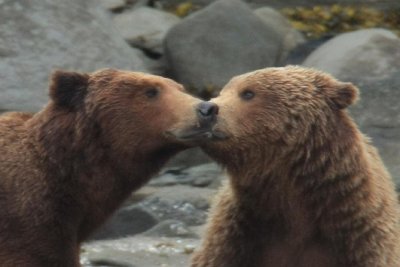
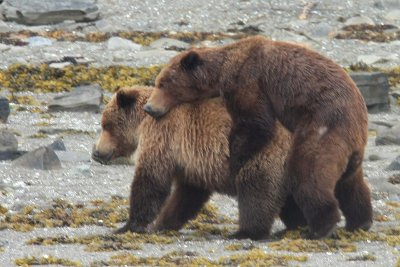
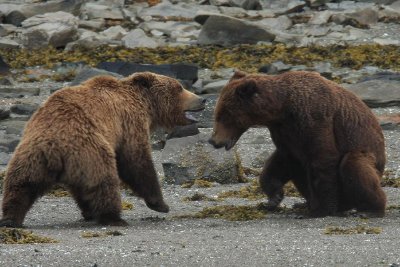
This is actually a rather funny bear story. I don't want to give the impression that bears are like people (because they aren't). On the other hand, when I see bears do something that reminds me of people, I have to face the fact that there are certain social behaviors shared by all mammals.
There are actually a number of bear behaviors that resemble human behavior, like triangles — I can't tell you how many romantic triangles I've seen played out. And teenage bear behavior very much resembles teenage human behavior — the recklessness arising from inexperience, the strong social bond and a tendency to hang out with a same-age group (although most groups of teenage bears are siblings).
But for me, the most interesting bear social behaviors come up in mating. It's interesting because it resembles human mating behavior, but without our posturing and illusion. As just one example, I often see a female bear throw a very familiar-looking "hell hath no fury" tantrum when a male bear loses interest at an inopportune time.
This story has some things in common with that, but with small distinctions. I'll call the bears John and Marsha just for convenience. At about 08:00, Marsha is out on the beach digging clams, and John appears from the brush. At first Marsha is startled and jumps away, but a familiar dance develops, both bears circling around, exploring, each bear slowly moving in toward the other.
At this point I think these two bears are a mating couple — they already know each other, but they aren't exclusive. I've seen bears change sexual partners in a matter of hours if the opportunity presents itself, but I also see what I call "swans" — a mating couple that is completely uninterested in other bears.
Well, I hate to break this to my male readers, but bears don't appear to need Viagra — they typically have extraordinary endurance by human standards. And I have an objective way to know how long a mating session lasts. My camera has an internal clock that time-stamps the photographs, so later on I can objectively establish how long something took, rather than relying on vague memory.
For example, the times attached to Figures 1-3 are accurate, and the entire episode, from beginning to end, lasted about 45 minutes. And Marsha not only wore John out, but once she realized he was unable to continue, she proceeded to tell him off (Figure 3). I thought this was a very instructive episode to witness because, as I said before, it resembled human mating behavior without the pretense and posturing.
Many women are very much into sex, but in most cases they can't get away with revealing or advertising this fact — the social consequences are too severe. But for bears, there aren't any social consequences, because ... there's no society. The largest meaningful social grouping of bears might be three adults in a romantic triangle, something that might last a couple of hours before evaporating. A family consisting of a mama bear and three cubs, total of four, might last 2½ to 3 years before the cubs go on their own (and hang out together for perhaps one more year as they move into adulthood).
Think about it. No language, no gossip, no lying, no bearing false witness. There are obvious advantages to language, like science and mathematics, two of my favorite things, but there are drawbacks to language that we often don't consider, things bears would have a hard time imagining. People often paint themselves into a corner by describing themselves in unrealistic ways (sometimes only fooling themselves), but then can't live up to the impression they've created. Bears don't have that burden — nearly everything is based on direct experience, so there's little chance for deceit.
Marsha could throw a fit about John's inability to last longer than 30 minutes just because no one would hear about it, and by the same token, no one would hear about John flaking out after "only" 30 minutes. A bear's social horizon doesn't extend beyond a particular time and place, the audible range of a growl, the reach of a paw.
Bears don't understand Calculus and I have no chance to teach them. That's too bad. On the other hand, they don't know what it is and don't care, so there's no sense of missed opportunity. Naturally this makes me wonder whether sufficiently advanced beings might find us limited in the same way, oblivious to a rich intellectual discipline entirely beyond our skills or imagination.
Below find one more bear picture, on a different subject.
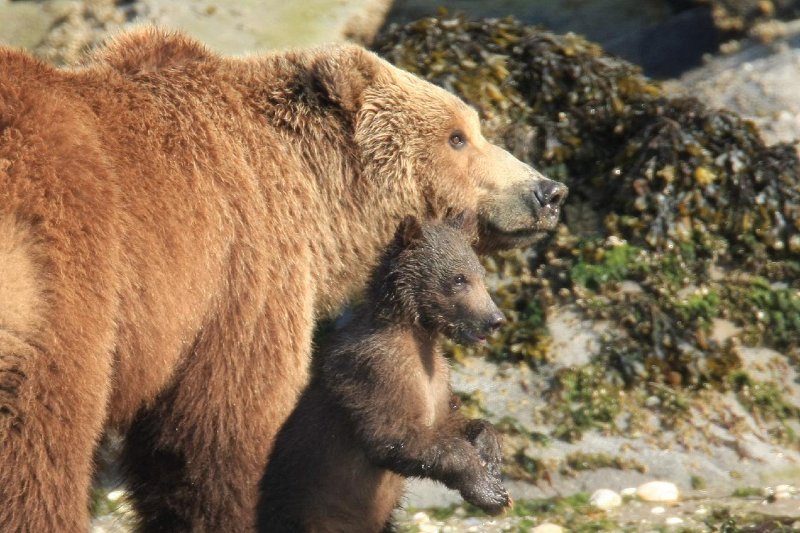
| Home | | Sailing | | Alaska 2009 | |  |  |  Share This Page Share This Page |